Complete Solutions to Exercise 2 of chapter CHEMICAL THERMODYNAMICS AND ENERGETIC of Class 12 book with complete answers and questions
| Class 12 | CHEMISTRY |
| Chapter | CHEMICAL THERMODYNAMICS AND ENERGETIC |
| MHTCET PREP GUIDE | Exercise 2 |
| Number Of Questions | 83 |
| Academic Year | 2023-24 |
The free energy change for the following reaction are given below:
`C_(2)H_(2)(g)+(5)/(2)O_(2)(g) to 2CO_(2)(g)+H_(2)O(l),DeltaG^(@)=-1234J`
`C(s)+O_(2)(g)toCO_(2)(g),DeltaG^(@)=-394kJ`
`H_(2)(g)+(1)/(2)O_(2)(g)toH_(2)O(l),DeltaG^(@)=-237kJ`
what is the standard free energy change for the reaction?
`H_(2)(g)+2C(s)toC_(2)H_(2)(g)`
View SolutionWhen one mole of monoatomic ideal gas at T temperature undergoes adiabatic change under a constant external pressure of 1 atm, change in volume is from 1 L to 2L. The final temperature in kelvin would be
View SolutionThe heat of neutralisation of a strong acid and a strong alkali is 57.0 kJ `mol^(-1)`. The heat released when 0.5 mole of `HNO_(3)` solution is mixed with 0.2 mole o KOH is
View SolutionA cylinder of gas is assumed to contain 11.2 kg of butane `(C_(4)H_(10))`. If a normal family needs 20000 kJ of energy per day, the cylinder will last in (given that `DeltaH` for combustion of butane is -2658 kJ)
View SolutionCalculate the enthalpy change on freezing of 1.0 mole of water at `10.0^(@)C` to ice at `-10.0^(@)C`
`[Delta_("fus")H=6.03kJmol^(-1)` at `0^(@)C]`
`C_(p)[H_(2)O(l)]=75.3Jmol^(-1)K^(-1)`
`C_(p)[H_(2)O(s)]=36.8Jmol^(-1)K^(-1)`
View SolutionIF 900 J/g of heat is exchanged at boiling point of water then increase in entropy is
View SolutionThe heat of atomisation of methane and ethene are 360 kJ/mol and 620 kJ/mol, respectively. The longest wavelenth of light capable of breaking the C-C bond is (Avogadro number `=6.02xx10^(23),h=6.62xx10^(-34)` Js)
View SolutionIn the given figure,
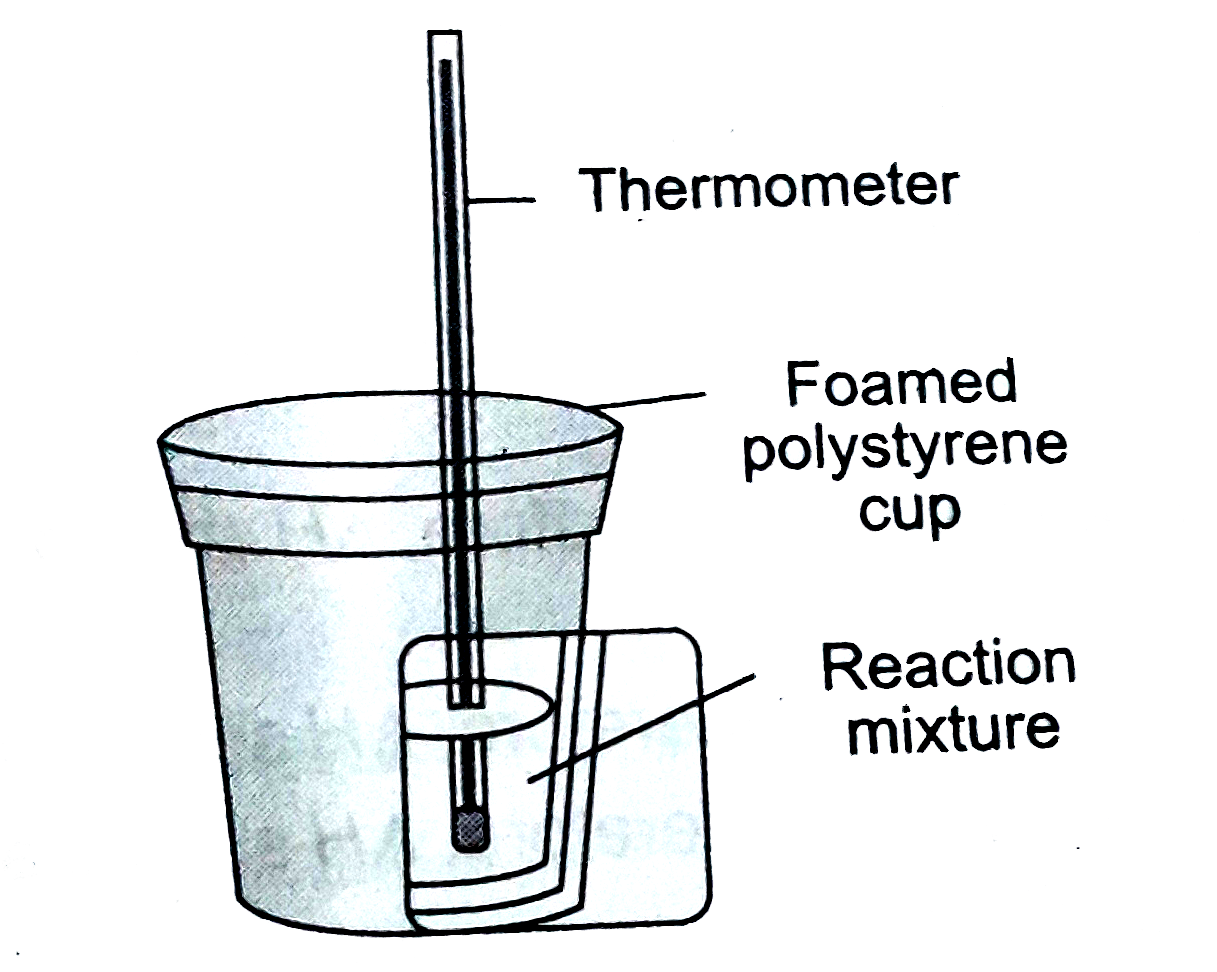
What does the above figure represent?
View SolutionEnergies requried to break the individual C-H bonds in each successive step differ
`CH_(4)(g)toCH_(3)(g)+H(g),Delta_("bond")H^(ө)=439" kJ "mol^(-1)`
`CH_(2)(g)toCH(g)+H(g),Delta_("bond")H^(ө)=439kJmol^(-1)`
`CH(g)toC(g)+H(g),Delta_(bond)H^(ө)=347kJmol^(-1)`.
In such cases we use
View SolutionUse the given data to calculate the resonance energy of `N_(2)O.(Delta_(f)H^(ө)` of `N_(2)O=82kJmol^(-1))`
Bond energy of N=O`to607kJmol^(-1)`
Bond energy of O=O`to498kJmol^(-1)`
bond energy of N=N`to418kJmol^(-1)`
Bond energy of `N-=Nto946kJmol^(-1)`
Choose the correct option.
View SolutionA reaction takes place in a several sequential steps A,B,C and D. the vlaue of enthalpy change for sequential steps are p,q,r and s respectively. If A and C have equal values of enthalpy change with total enthalpy change is t, then choose the incorrect statement among the following.
View SolutionThe pressure volume work for an ideal gas can be calculated by using the expression `W=-int_(V_(i))^(V_(f))p_(ext)dV`. The work can also be calculated from the pV-plot by using the area under the curve within the specified limits. When an ideal gas is compressed (a) reversibly or (b) irreversibly from volume `V_(i)` to `V_(f)`. choose the correct option.
View SolutionDifferent stages of the thermodynamic process are given in the pV diagram.
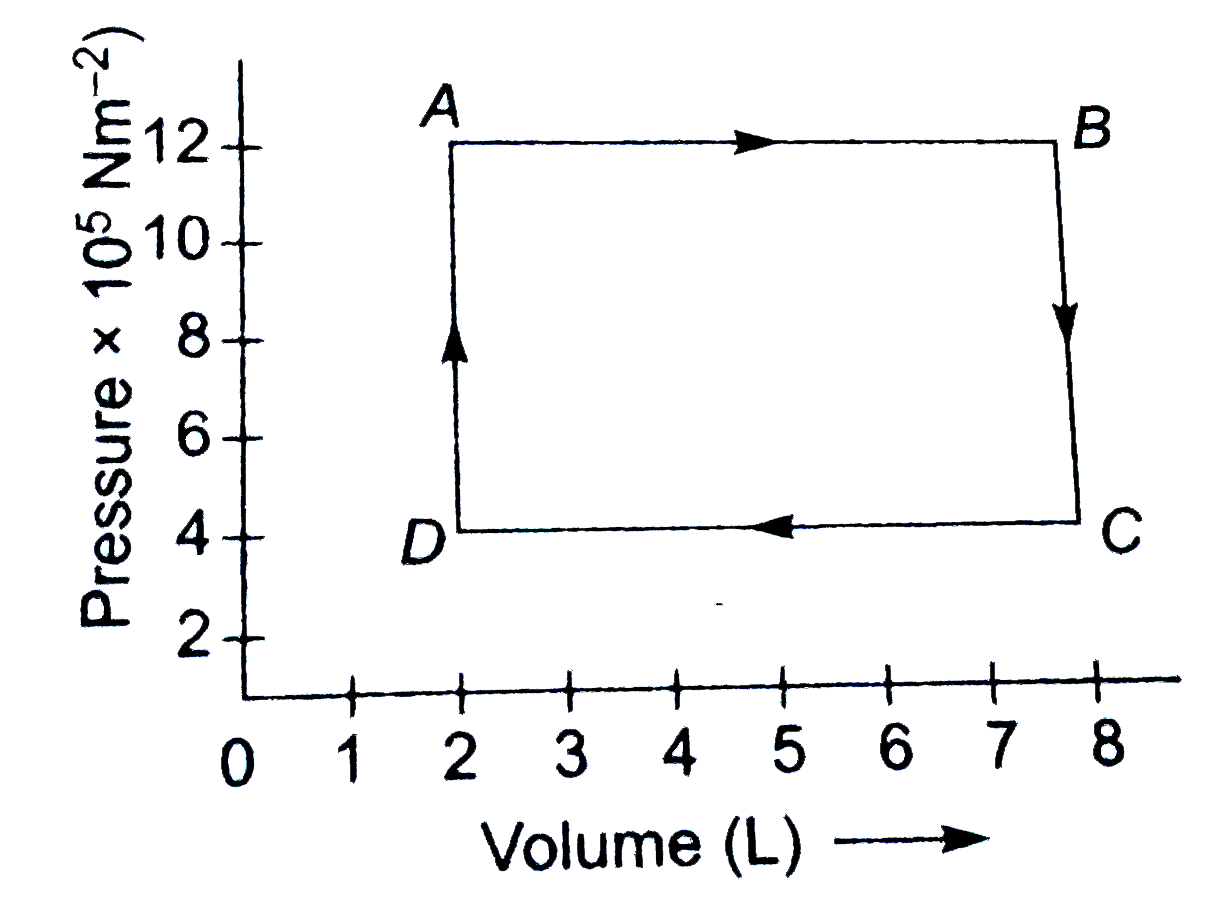
Calculate the work done is each stage.
View SolutionThe (i)_____of a syste can be changed by transfer of heat from the surrounding to the system of cive-verse without expenditure of (ii)_____.
Identify (i) and (ii) in order to complete the above statement.
View SolutionMolar enthalpy change for vaporisation of 1 mole of water at 1 bar and `100^(@)C` is 41 kJ `mol^(-1)` (If water vapour is assumed to be perfect gas). Find out of the internal energy change. If 1 mole of water is vaporised at 1 bar pressure and `100^(@)C`.
View SolutionThe heat of reaction for
`C_(10)H_(8)(s)+12O_(2)(g)to 10CO_(2)(g)+4H_(2)O(l)`
at constant volume is -1228.2 kcal at `25^(@)C`. The heat of reaction at constant pressure and same temperature is
View SolutionThe graph expresses the various steps of the system containing 1 mole of gas. Which type of process system has when it moves from C to A?

View SolutionIf the bond dissociation energies of `XY,X_(2) and Y_(2)` (all diatomic molecules) are in the ratio of 1:1:0.5 and `DeltaH_(f)` for the formation of XY is -200 kJ `mol^(-1)`. The bond dissociation energy of `X_(2)` will be
View SolutionThe equilibrium constannt of a reaction is 0.008 at 298 K. the standard energy change of the reaction at the same temperature is
View SolutionThe ratio of heats liberated at 298 K from the combustion of one kg of coke and by burning water gas obtained from 1kg of coke is (assume coke to be 100% carbon). (Given: Enthalpies of combustion of `CO_(2),CO and H_(2)` are 393.5 kJ, 285 kJ, 285 kJ respectively all at 298K)
View SolutionThe value of `DeltaH` for cooling 2 moles of an ideal monoatomic gas from `225^(@)C` to `125^(@)C` at constant pressure will be [given `C_(p)=(5)/(2)R`]
View SolutionWhich of the following statement is correct for the spontaneous adsorption of a gas?
View SolutionThe value of enthalpy change `(DeltaH)` for the reaction `C_(2)H_(5)OH(l)+3O_(2)(g)to2CO_(2)(g)+3H_(2)O(l)`, at `27^(@)C` is `-1366.5" kJ "mol^(-1)`. The value of internal energy change for the above reaction at this temperature will be
View SolutionA plot of ln k against `(1)/(T)` (abscissa) is expected to be a straight line with intercept on coordinate axis equal to
View SolutionA container of 1.0 L capacity filled with 1.0 mole of ideal gas is connected to an evacuated vessel to 9L. Calculate change in entropy. (R=1.987 cal.)
View SolutionIn which of the following reactions, the enthalpy is the least?
View SolutionFor a particular reversible reaction at temperature `T,DeltaH and DeltaS` were found to be +ve. If `T_(e)` is the temperature at equilibrium, the reaction would be spontaneous when
View Solution`C(s)+O_(2)(g)toCO_(2)(g),DeltaH=-94` kcal
`2CO(g)+O_(2)to2CO_(2),DeltaH=-135.2` kcal
The heat of formation of `CO(g)` is
View SolutionThe heat of formations for `CO_(2)(g),H_(2)O(l) and CH_(4)(g)` are -400 kJ `mol^(-1),-280" kJ "mol^(-1) and -70" kJ "mol^(-1)`, respectively. The heat of combustion of `CH_(4)` in kJ `mol^(-1)` is
View SolutionA hypothetical reaction `Ato2B`, proceeds through following sequence of steps
(i) `A to C,DeltaH=q`
(ii) `C to D,DeltaH=v`
(iii) `(1)/(2)D to B,DeltaH=x`
Then, the heat of reaction is
View Solution`DeltaH` for the reaction,
`C("graphite")+2H_(2)(g) to CH_(4)(g)`
at 298 K and 1 atm is -17900 cal. The `DeltaE` for the above conversion should be
View SolutionThe decreasing order of bond dissociation energies of C-C,C-H and H-H bonds is
View SolutionIf the end energies of H-H, Br-Br and H-Br are 433, 1992 and 364 kJ `mol^(-1)` respectively, then `DeltaH^(@)` for the reaction, `H_(2)(g)+Br_(2)(g)to2HB r(g)` is
View SolutionAt `27^(@)C` one mole of an ideal gas is compressed isothermally and reversibly from a pressure of 2 atm to 10 atm. The value of `DeltaE` and q are (R=2 cal)
View SolutionThe internal energy change when a system goes from state A to B is 40 kJ/mol. I the system goes from A to B by a reversible path and return to state A by a irreversible path, what would be the net change in internal energy?
View SolutionGiven, `2Fe+(3)/(2)O_(2)toFe_(2)O_(3),DeltaH=-193.4kJ,Mg+(1)/(2)O_(2)to MgO,DeltaH=-140.2kJ`
What is the `DeltaH` for the following reaction?
`3Mg+Fe_(2)O_(3) to 3MgO+2Fe`
View SolutionEnthalpy of formation off HF and HCl are -161 kJ and -92 kJ, respectively. Which of the following statements is incorrect?
View SolutionFor the reaction, `2H_(2)+O_(2) to 2H_(2)O,DeltaH=571.` bond energy of H-H=435, O=O=498, then calculate the average bond energy of O-H bond using the above data
View SolutionThe bond energy of ann O-H bond is 109 kcal/mol. When 1 mole of water is formed, then
View SolutionGiven the following thermochemical equations,
`Zn+(1)/(2)O_(2) to ZnO+84,000` cal
`Hg+(1)/(2)O_(2)toHgO+21,700` cal
Accordingly the heat of reaction for the following reaction, `Zn+HgO to Hg+`heat is
View SolutionThe enthalpy of vaporisation of liquid water using the data
`H_(2)(g)+(1)/(2)O_(2)(g)toH_(2)O(l),DeltaH=-285.77kJ//mol`
`H_(2)(g)+(1)/(2)O_(2)(g)toH_(2)O(g),DeltaH=-241.84kJ//mol`
is
View SolutionEnergy requried to dissociate 4 g of gaseous hydrogen into free gaseous atoms is 208 kcal at `25^(@)C`. The bond energy of H-H will be
View SolutionThe enthalpy of a monoatomic gas at T kelvin is
View SolutionThe enthalpy change `(DeltaH)` for the process, `N_(2)H_(4)(g)to 2N(g)+4H(g)` is
is 1724 kJ `mol^(-1)`. If the bond energy of N-H bond in ammonia is 391 kJ `mol^(-1)`, what is the bond energy for N-N bond in `N_(2)H_(4)`?
View Solution`CH_(2)=CH_(2)(g)+H_(2)(g) to CH_(3) to CH_(3)(g)`
The heat of reaction is [bond energy of C=C=80 kcal, C=C=145 kcal, C-H=98 kcal, H-H=103 kcal]
View SolutionThe following is (are) endothermic reaction
I. combustion of methane.
II. Decomposition of water.
III. Dehydrogenation of ethane to ethylene
IV. Conversion of graphite to diamond
View SolutionIn a calorimeter, the temperature of the calorimeter increases by 6.12 K, the heat capacity of the systemm is 1.23 kJ/g/deg. What is the molar heat of decomposition for the ammonium nitrate?
View SolutionConsider the following reaction and corresponding energy diagram: `AtoP`
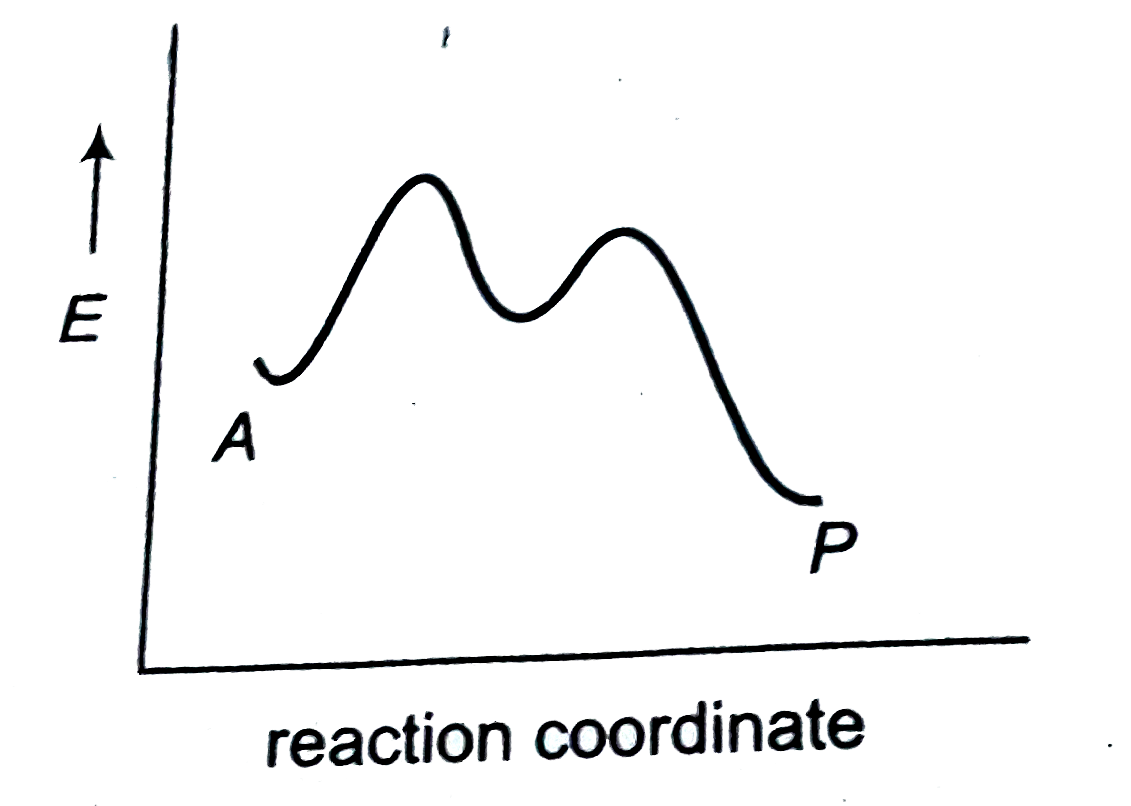
which of the following statements is incorrect?
View SolutionHeat of formation of `H_(2)O` is -188kJ/mol and `H_(2)O_(2)` is -286 kJ/mol. The enthalpy change for the reaction,
`2H_(2)O_(2) to 2H_(2)O+O_(2)`
View Solution`DeltaH` for combustion of ethene and ethyne are -341.1 and -310.0 kcal, respectively. What will be the ratio of calorific values of ethane and ethyne, respectively?
View Solution2.1 g of Fe combines with S evolving 3.77 kJ. The heat of formation of FeS (in kJ/mol) is
View SolutionThe standard enthalpy of formation of `NH_(3)` is `-46.0kJmol^(-1)`. If the enthalpy of formation of `H_(2)` from its atoms is `-436kJmol^(-1)`, the average bond enthalpy of N-H bond in `NH_(3)` is
View Solution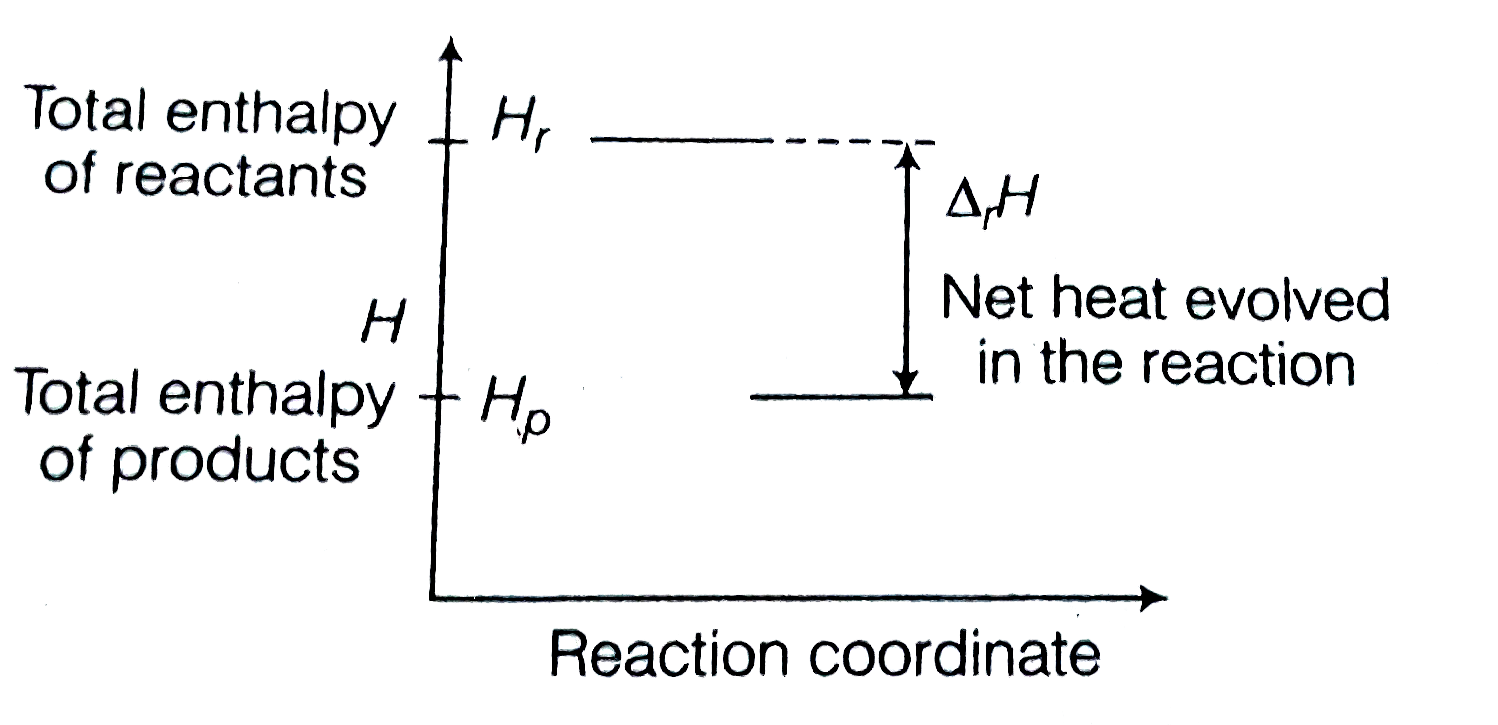
The above diagram represents
View SolutionCalculate the bond enthalpy of `Xe-F` bond as given in the equation,
`XeF_(4)(g)toXe^(+)(g)+F^(-)(g)+F_(2)(g)+F_(g),Delta_(r)H=292" kcal "mol^(-1)`
Ionisation energy of Xe=279 kcal/mol bond energy (F-F)=38 kcal/mol
Electron affinity of F=85 kcal/mol
View Solution18 g of water is taken to prepare, the tea. Find out the internal energy of vaporisation at `100^(@)C. (Delta_(vap)H^(ө)` for water at `373K=40.66kJmol^(-1))`
View SolutionWhich of the following statement is incorrect about the equation?
`C_(2)H_(5)OH(l)+3O_(2)(g) to 2CO_(2)(g)+3H_(2)O(l),Delta_(r)H^(-)=-1367" kJ "mol^(-1)`
View SolutionCalculate the enthalpy of vaporisation of `I_(2)` if the sublimation energy and enthalpy of fusion of `I_(2)` is 57.3 kJ `mol^(-1)` and 15.5 kJ `mol^(-1)` respectively
View SolutionA system containing some quantity of water in a thermos flask or in an insulated beaker. This would not allow exchange of heat between the system and surrouding through its boundary. This process is called as
View SolutionFor the reaction `AtoB,DeltaH=+23kJ//mol and BtoC,DeltaH=-18kJ//mol`, the decreasing order of enthalpy of A,B,C follows the order
View SolutionThe ratio of enthalpy of vaporisation and the normal boilng point of a liquid approximately equals to (i)_____. The above statement follows the (ii)______. Choose the correct word to complete the above statement.
View SolutionArrange the following units in the decreasing order of their value
View SolutionThe reaction of cyanamide, `NH_(4)CN(s)`, with dioxygen was carried out in a bomb calorimeter, and `DeltaU` was found to be -742.7 kJ `mol^(-1)` at 298 K. calculate the enthalpy change for the reaction at 298 K.
`NH_(4)CN(g)+(3)/(2)O_(2)(g) to N_(2)(g)+CO_(2)(g)+H_(2)O(l)`
View SolutionConsider the following reactions:
(i) `(1)/(2)N_(2)(g)+(1)/(2)O_(2)(g) to NO(g),Delta_(r)H^(ө)=90" kJ "mol^(-1)`
(ii) `NO(g)+(1)/(2)O_(2)(g) to NO_(2)(g),Delta_(r)H^(ө)=-74" kJ "mol^(-1)`
Select the correct statement about the given reaction.
View SolutionIn view of the signs of `DeltaG^(ө)` for the following reactions,
`PbO_(2)+Pb to 2PbO,Delta_(r)G^(ө) lt 0`,
`SnO_(2)+Snto 2SnO,Delta_(r)G^(ө) gt 0`
Which oxidation states are more characteristic for lead and tin?
View SolutionIn an irreversible process taking place at constant T and p and in which only pressure volumee work is being done, the change in Gibbs free energy (dG) and change in entropy (dS), satisfy the criteria.
View SolutionIn adiabatic conditions 1 mole of `CO_(2)` gas at 300 K is expanded such that its volume becomes 27 times. Calculate the work done.
(`C_(V)=6" cal "mol^(-1) and gamma=1.33` is given)
View Solution`Delta_(f)U^(ө)` for the formation of `CH_(4)(g)` at certain temperature is -393 kJ `mol^(-1)`. The value of `Delta_(f)H^(ө)` is
View Solution1.0 mole of a monoatomic ideal gas is expanded from state (I) to state (II) as shown in the figure. Calculate the work done for the expansion of gas from state (I) to state (II) at 298K.
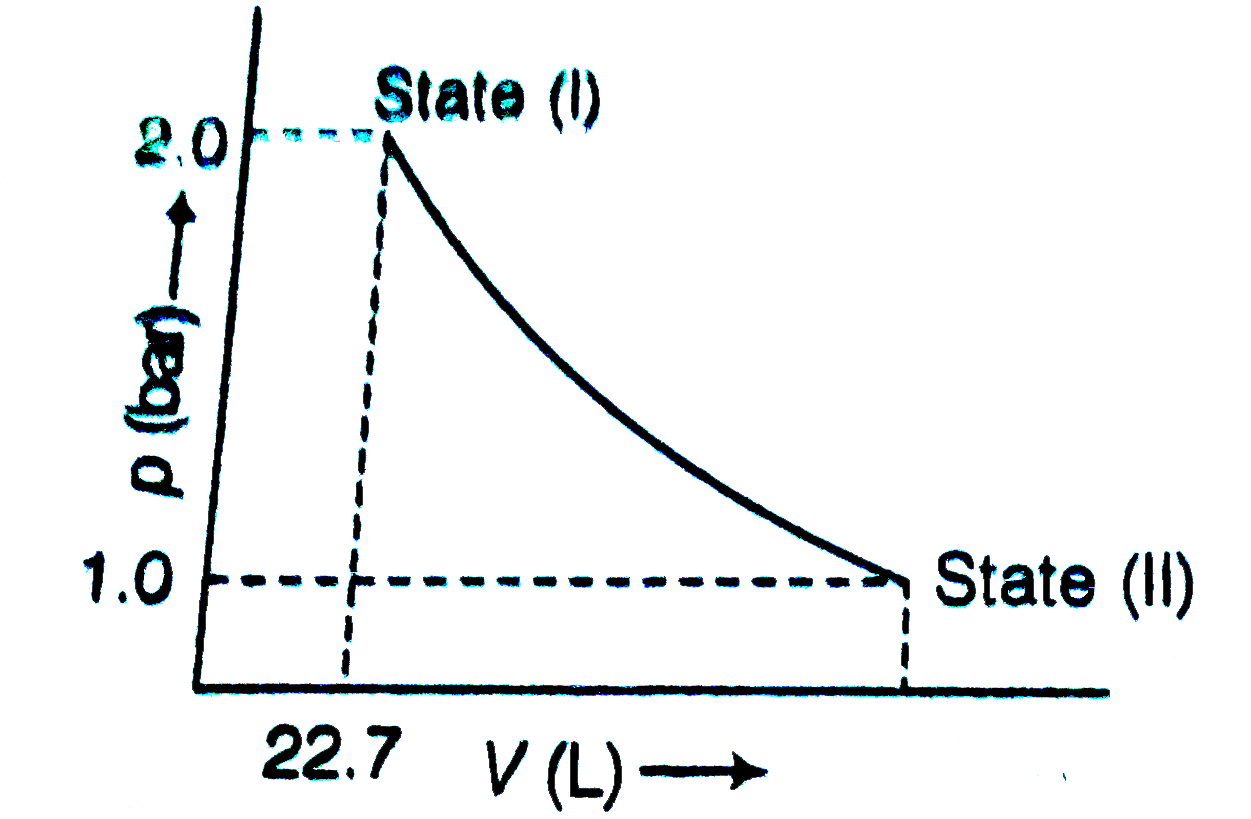
View SolutionWhat is the equilibrium constant, K for the following reaction at 400 K?
`2NOCl (g) hArr 2NO(g)+Cl_(2)(g)`
`DeltaH=77.2" kJ "mol^(-1) and DeltaS=122JK^(-1)mol^(-1)` at 400K.
View SolutionMatch the columns with the laws of thermodynamics.

View SolutionMatch the columns with the atomicity of gases to the heat capacity at constant pressure `(C_(p))`.

View SolutionAn ideal gas is allowed to expand against a constant pressure of 2 bar from 10 L to 50 L in one step. The amount of work done by the gas is x. if the same expansion were carried out reversible, what is the relation of work done with the earlier case?
View Solution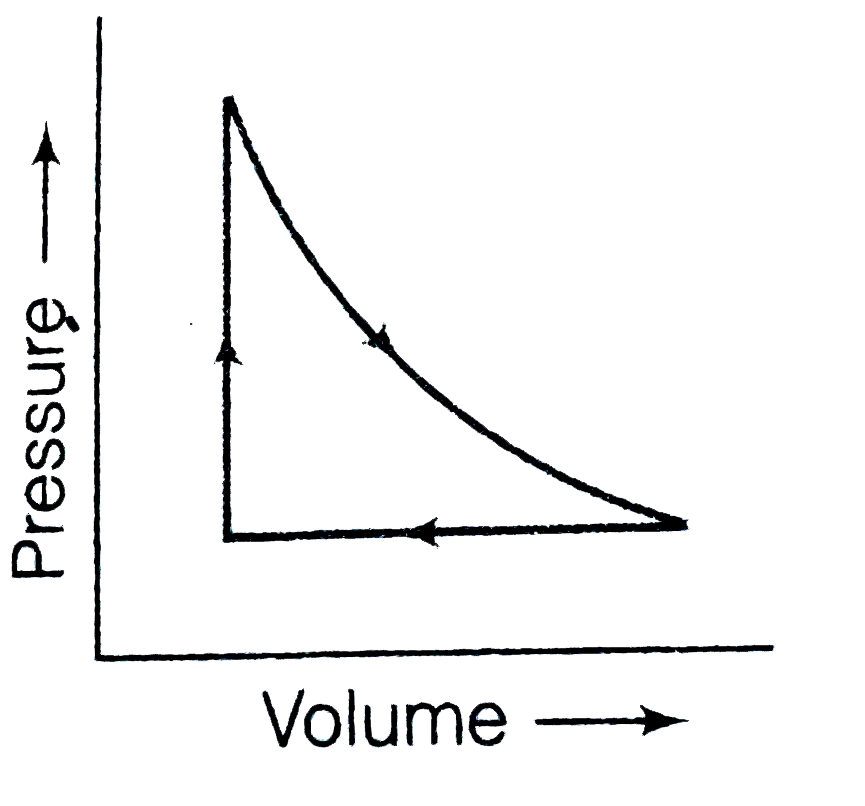
A sample of 1.0 mole of a monoatomic ideal gas is taken through a process of expansion and compression as shown in the figure. What will be the value of `DeltaH` for the process as a whole?
View SolutionWhat would be the heat released when an aqueous solution containing 0.5 mole of `HNO_(3)` is mixed with 0.3 mle of `OH^(-)`? (Enthalpy of neutralisation is -57.1 kJ)
View SolutionThe molar heat capacity of water at constant pressure is 75 `JK^(-1)mol^(-1)`. When 1.0 kJ of heat is supplied to 100 g of water which is free to expand the increase in temperature of water is
View SolutionFor a reaction at `25^(@)C`, enthalpy and entropy changes are `-11.7xx10^(3)" J "mol^(-1) and -105" J "mol^(-1)K^(-1)` respectively. What is the Gibb's free energy?
View SolutionThe standard molar heat of formation ethane, `CO_(2)` and water (l) are respectively -21.1, -94.1 and -68.3 kcal. The standard molar heat of combustion of ethane will be
View SolutionThe `DeltaH_(f)^(@)` of `O_(3),CO_(3),NH_(3) and HI` are 142.2, -393.3, -46.2 and +25.9 kJ per mol, respectively. The order of their increasing stabilities will be
View SolutionOne molee of methanol when burnt in `O_(2)`, gives out 723 kJ `mol^(-1)` of heat. If one mole of `O_(2)` is used, what will be the amount of heat evovled?
View Solution`DeltaH_(f)^@` (298K) of methanol is given by the chemical equation,
View SolutionFormation of a solution from two components can be considered as
(1). pure solvent`to`separated solvennt molecules, `DeltaH_(1)`
(2). Pure solute `to`separated solute molecules, `DeltaH_(2)`
(3). Separated solvent and solute molecules`to`solution, `DeltaH_(3)`
Solution so formed will be ideal if
View SolutionIf the value of `C_(p)` for nitrogen gas is 7 `JK^(-1)mol^(-1)`, then the value of `DeltaH` on heating 28 g of nitrogen gas from `0^(@)C` to `100^(@)C` at constant pressure will be
View SolutionThe equilibrium concentration o the species in the reaction `A+B hArr C+D` are 3,5,10 and 15 mol `L^(-1)` respectively. At 300 K, the `DeltaG` for the reaction is
View Solution
Exercise 2 questions and complete solutions for chapter CHEMICAL THERMODYNAMICS AND ENERGETIC of MHTCET PREVIOUS YEAR PAPERS AND PRACTICE PAPERS of Class 12